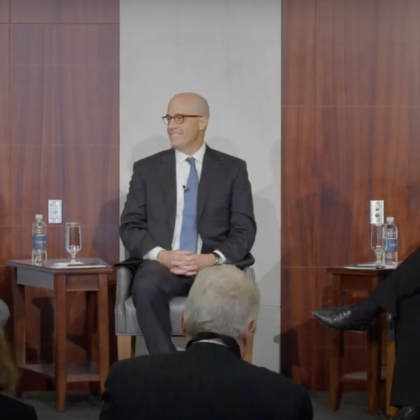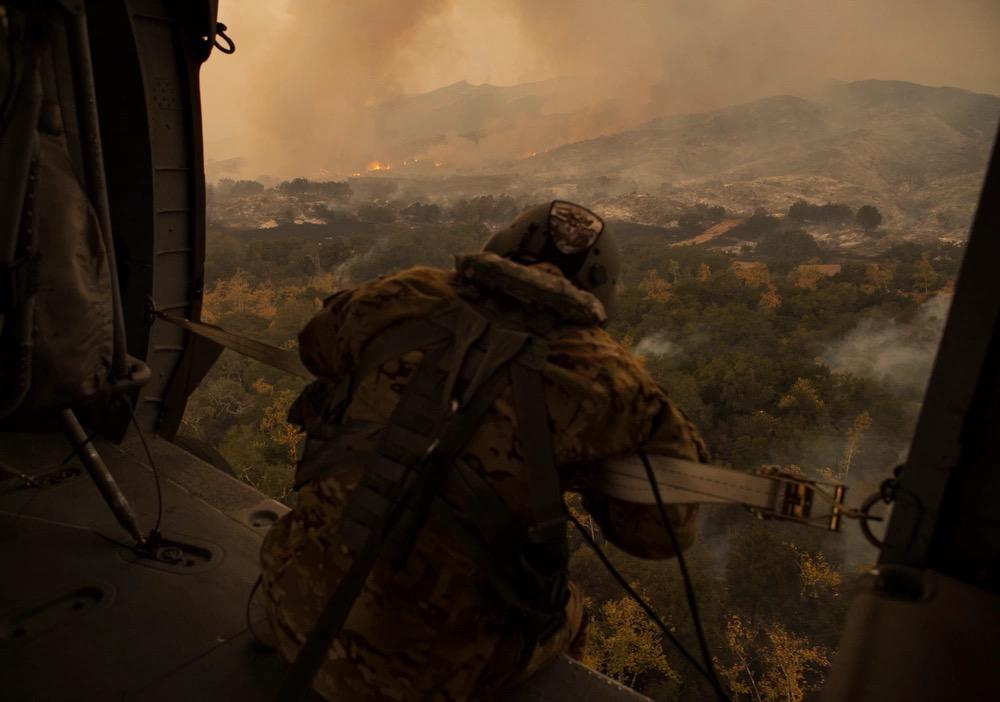Army Takes First Steps To Implement Climate Mitigation
Amid hurricane season—and the damage Hurricane Ian ravaged on Florida and other areas—the U.S. Army released its five-year Climate Strategy Implementation Plan (ACS-IP). To face the possible impacts of climate change that threaten Army missions, infrastructure and people, the service’s approach is two-fold: to create a climate- and sustainability-informed workforce and to integrate climate change adaptation and mitigation steps into its existing operations and programs. The service’s military academy at West Point is also stepping into action by adding sustainability, resilience and climate change education for cadets and a consortium in which to work directly with the Army on related issues.
The Army’s implementation plan, set by Rachel Jacobson, the assistant secretary of the Army for Installations, Energy and Environment (IE&E) and Daniel Klippstein, the assistant deputy chief of staff or G-9, builds on the Army's Climate Strategy that was approved by the Secretary of the Army Christine Wormuth and published in February. The policy’s initial set of actions for fiscal years 2023-2027 specifically focuses on the near-term tasks, necessary analyses and planning that “lay the groundwork for future action,” the document noted.
“Soldiers are already experiencing changing physical environments,” the implementation plan stated. “Scientific forecasts predict that those environmental changes will become more severe as the 21st century progresses. Through the activities, investments, and initiatives identified in the ACS-IP, plus countless other ongoing efforts, the Army will lead and inspire innovation and cutting-edge technology-driven solutions to meet this reality. By reducing GHG [greenhouse gas] emissions and mitigating the effects of climate change, the Army’s mission will be more sustainable well into the future.”
At an October 6 event at the Center for Strategic and International Studies (CSIS), Paul Farnan, principal deputy assistant secretary of the Army for IE&E and Sharon Burke, former assistant secretary of defense for Operational Energy Plans and Programs, Department of Defense, spoke with Morgan Higman, CSIS fellow, Energy Security and Climate Change Program, about the Army’s climate implementation plan efforts.
For example, the service plans to develop 20 microgrid projects, either designed or under construction by 2024. And by 2027, the service aims to increase its microgrid coverage to 50% of critical mission demand on mission assurance installations, power projection platforms and mobilization force generation installations, according to the plan.
For the microgrid efforts, the IE&E and the deputy assistant secretary of the Army for Energy and Sustainability will oversee the tasks, while the Army Corps of Engineers and the Army Reserve will complete the installation.
“What we need is self-contained generation, and it just so happens that the best self-contained generation is also carbon-free generation,” Farnan offered. “We have a goal for every one of our installations to have a microgrid installed by 2035. And that will allow the connection of on-site generation. It will allow us also to island the base and island our mission-critical systems so that we can focus and so that we can still operate if the grid does go down.”
By the end of 2023, the service plans to reduce its greenhouse gas emissions from its property portfolio by 10%, down from a 2008 baseline. In another measure, the service plans to incorporate carbon sequestration considerations and decision support modeling into land management guidance and decision processes.

Complete electrification of our tactical vehicles; that is a long-term goal. Our goal is 2050. People ask me this all the time, how are you going to do this, and the honest answer is I don’t know. The technology is not there to give us full electrification of tactical vehicles. I don’t know how we’re going to do battlefield charging yet. Nobody knows that.
Regarding vehicle emissions, by 2027, the Army aims to field a 100% zero-emission light-duty non-tactical vehicle fleet. For tactical vehicles on the battlefield, however, addressing emissions is a much greater challenge, according to Farnan.
“Complete electrification of our tactical vehicles; that is a long-term goal. Our goal is 2050,” Farnan said. “People ask me this all the time, how are you going to do this, and the honest answer is I don’t know. And that’s why the goal is out to 2050 because we don’t know how we’re going to get there yet. The technology is not there to give us full electrification of tactical vehicles. I don’t know how we’re going to do battlefield charging yet. Nobody knows that.”
Alternative fuel vehicles are needed to offer resiliency on the battlefield, the officials continued. “We’ve all seen the tanks sitting without fuel along the road,” Farnan said.
“And they have been sitting for a variety of reasons,” Burke added. “You got to get fuel, and the less fuel [dependency] you have, the better [off] you are,” Farnan noted.
Industry will play a key role in the vehicle transformation, Farnan emphasized, saying, “The next step is going to be the full hybridization and we’re working with industry on getting our vehicles fully hybridized …. and it’s an iterative process, so by the end of the decade, we’ll be actually producing hybridized vehicles…. We’re working with our acquisition team, we’re working with Army Futures Command to start figuring out now how we’re going to get there.”
For Burke, “the Army’s been interested in hybridization forever. They’ve been looking at doing this for vehicles for what, 20 or 30 years, because it gives you a performance gain. The Army Futures Command was looking at some concepts with electrification of the battlefield 10 years ago. So this strategy is really building on some interest in the Army that’s long-standing.”
And given that the vision of the Army’s Climate Strategy extends through 2050, the implementation plan does aim to recalibrate actions along the way to meet those Climate Strategy’s goals or desired “end-state” by that time. The service also plans to use “a dynamic process with a robust data collection” over this initial five-year period to support this recalibration and integrate best practices and new science and technology.
“Through the end of FY 27, the United States Army will leverage its enterprise and execute initiatives to adapt to and operate in climate-altered environments, mitigate Army greenhouse gas emissions and set the conditions for achieving the ACS [Army Climate Strategy] end state, all of which support the nation’s climate change goals and address national security threats,” the implementation plan stated.
Farnan acknowledged that climate change wasn't initially something that the military would naturally pursue. He was, however, impressed with how the Army has taken on such a challenge. “I was extremely pleased with how the Army embraced this, “Farnan said. “And I mean every facet of the Army, not just a bunch of policy wonks in the Pentagon. We talked to every single major command in the Army and supporting commands below that. Everybody was fully onboard supporting, sending great ideas, working with us to hammer out details.”
Burke added, “When you talk about what does it mean for a military to be considering the environment, it’s an interesting question…. It is not just how you clean up the aftermath of a war, but how do you fight in a way that’s not so destructive to your own country or to countries which could become your partners and your allies?"
Meanwhile, at West Point, the service academy and IE&E announced a new partnership that will create the so-called Sustainable Infrastructure, Resilience and Climate Consortium, or SIRCC. The effort will help “educate future Army leaders on how sustainability and resilience can increase the readiness of the force while simultaneously addressing the threats of climate change,” according to an Oct. 6 West Point statement.

“Building on years of collaboration and research, the consortium will leverage the intellectual capital of West Point and focus on supporting the Army Climate Strategy to improve mission capability, sustainability of Army infrastructure and enhanced resilience of the fighting force,” the release indicated.
The combined effort will provide cadets the opportunity to pursue degrees or classes in the fields of sustainability and resilience, expanding course development at West Point. The consortium will bring into the classroom prominent leaders speaking on sustainability and resilience issues. In addition, faculty and cadets will collaborate with the assistant secretary of the Army for IE&E to examine the integration of and connections between national security, sustainable infrastructure, resilience and climate change.
“This alliance is a prime example of how West Point develops cadets and faculty members as leaders of character by challenging them to innovate to solve complex Army problems," said West Point’s Dean of the Academic Board Brig. Gen. Shane R. Reeves. "Opportunities to work directly with Army leaders like Hon. Rachel Jacobson and her team are central to that effort. We are grateful for their continued support."
The service academy hopes that the new curriculum will help develop the next generation of leaders who will go into company and field-grade levels with the understanding of climate change and how it impacts the Army.
“This joint initiative between IE&E and West Point will significantly enhance the Army’s sustainability and resiliency goals by educating future Army leaders on these important topics,” said Jacobson in the release. “We hope that the support for SIRCC, as it gets started, will position the academy well into the future to engage cadets in challenging, critical discussions regarding the security implications of climate change, energy, water, resilience and sustainability, all of which directly impact the Army’s readiness and modernization efforts.”
Moreover, Farnan suggested that the IE&E team was “open to conversations with other universities and colleges,” in addition to working with West Point.
"It's about educating the force on the climate's impact on our operations and the impact our operations have on the climate," he said.

CSIS: Launch: Army Climate Implementation Plan
Moderated by Morgan Higman, senior fellow with the CSIS Energy Security and Climate Change Program.




Comments